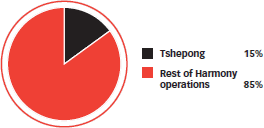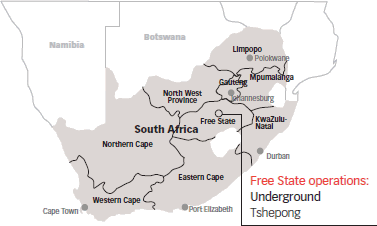![Harmony [logo]](i/logo.png)
![Harmony [logo]](i/print_logo.png)

- Home <
- Business review <
- Review of operations <
- South Africa <
- Tshepong
In this section
Tshepong
Contribution to group production – FY10


Description
Located in the Free State, Tshepong is Harmony’s largest operation. The Tshepong mine comprises a single vertical shaft extending to a depth of 2 161 metres below collar. Ore is transported to the Harmony 1 plant, 23 kilometres away. The Tshepong sub-71 decline project is in progress and will extend mining to a depth of 2 366m below surface while the sub-66 project is currently building up production. The mine undertakes conventional undercut mining on the Basal Reef. The B reef is exploited as a high-grade secondary reef.
Tshepong employed 5 064 people in FY10, of whom 4 901 were employees and 163 contractors.
Detailed information on Tshepong’s resources and reserves is available in the Mineral resources and mineral reserves section of this annual report.
Safety
Overall safety performance improved in FY10. There were regrettably two fatalities during the year, compared with seven the previous year and the LTIFR declined to 12.22 per million hours worked (FY09: 15.82). In addition, Tshepong achieved 1 million fatality-free shifts on 18 February 2010 and came seventh in the category for the most improved LTIFR at the second Hard Rock Safety Summit.
More detailed information on safety performance and Harmony’s sustainable development concerns in South Africa can be found in the online Sustainable Development Report. A summary of this can be found under Harmony and sustainability.
| Production | FY10 | FY09 | FY08 | |
|---|---|---|---|---|
| Volumes milled | 000t (metric) | 1 518 | 1 375 | 1 495 |
| 000t (imperial) | 1 674 | 1 516 | 1 649 | |
| Gold produced | kg | 6 749 | 7 178 | 8 271 |
| oz | 216 986 | 230 778 | 265 914 | |
| Average grade | g/t | 4.45 | 5.22 | 5.53 |
| oz/t | 0.130 | 0.152 | 0.161 | |
| Financial | ||||
| Revenue | R million | 1 823 | 1 780 | 1 621 |
| US$ million | 241 | 198 | 223 | |
| Operating cost* | R/kg | 164 938 | 139 901 | 105 800 |
| US$/oz | 677 | 483 | 455 | |
| Operating profit | R million | 676 | 802 | 715 |
| US$ million | 90 | 89 | 98 | |
| Capital expenditure | R million | 261 | 249 | 195 |
| US$ million | 35 | 28 | 27 | |
| Sustainability | ||||
| Number of employees | ||||
| Employees | 4 901 | |||
| Contractors | 163 | |||
| Total | 5 064 | |||
| HDSAs in management** | % | 30 | ||
| Women in mining** | % | 11 | ||
| Expenditure on training and development | R million | 23 | ||
| Safety | ||||
| No. of fatalities | 2 | |||
| LTIFR | per million hours worked | 12.22 | ||
| Environment | ||||
| Energy used | 000MWh | 288 | ||
| Water used for primary activities | 000m3 | 1 144 | ||
| GHG emissions | 000t CO2e | 347 | ||
| Expenditure on local economic development | R million | 6 | ||
| Status of mining right | New order mining right granted in December 2007 | |||
* Includes royalty payment in FY10
** Indicator reported in terms of the MPRDA and the South African Mining Charter
Operations review
Tonnes milled rose by 10% to 1.5Mt in FY10. However, a 15% decline in grade resulted in a 6% reduction in gold produced to 216 986 ounces. The increase in ore milled, which exceeded expectations, was a result of the increase in square metres mined (from 378 039m² in FY09 to 385 978m² in FY10) and the additional volumes of development waste from the decline which had been trammed to reef. The latter however added to the challenge posed by the lower face grade as mining is currently taking place at the edge of the payshoot where values are more erratic.
Currently under development, the sub-71 project, which will connect Tshepong with Phakisa, remains on track for completion in May 2012. This project extends the existing double decline from 71 to 76 level to enable mining on both the 73 and 75 levels. The project’s ultimate goal is to sink the decline to 76 level by May 2012.
Tshepong’s full production of around 236 000 ounces annually is scheduled for 2015 with 1.41Mt being mined at an average recovered grade of 5.19 g/t. The average productivity target at full production is 139g/TEC.
Much of the development at the start of the year took place at the edges of the Basal Reef payshoot which resulted in lower development grades. These improved in the second half of the year when new raise lines became available within the deeper extension payshoots in the sub-66 and sub-71 decline areas. Development on the higher-grade channels of the B Reef stalled with the intersection of areas of non-deposition.
Financial review
Revenue rose by 2% to R1 823 million and by 22% to $241 million. Cash operating cost rose by 18% to R164 938/oz and by 40% to US$677/oz with cost pressure coming from increases in wages, electricity tariffs and the cost of supplies and equipment.
Capital expenditure was 5% higher at R261 million (US$35 million), spent primarily on on-going development, major equipment maintenance and other shaft capital, and the sub-71 decline project. Total expenditure to date on this project is R133 million (US$18 million).
Outlook*
Tshepong should achieve its reserve grade of 1 132cmg/t once the mine is fully able to access the orebody through the declines. Volumes are expected to decrease 9% to 1.38Mt in FY11 at a recovered grade of 4.75g/t . Gold production of 6 532 kilograms (210 000 ounces) is planned at an anticipated cash cost** of R187 913 /kg (US$766 /oz).
Total capital expenditure** of R273 million (US$36 million) is planned for FY11 – R177 million (US$23 million) on on-going development, R17 million (US$2 million) on major equipment maintenance and R22 million (US$3 million) on other shaft capital. The balance of R57 million (US$8 million) is planned for the sub-71 decline project.
Current productivity levels of 122g/TEC are forecast to remain constant despite the forecast decrease in gold production.
* Please refer to the forward-looking statements
** June 2010 money terms. The exchange rate of R7.63/US$ as at 30 June 2010 has been used for all forward-looking conversions.
HARMONY ANNUAL REPORT 2010